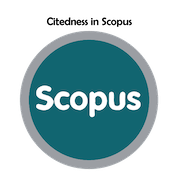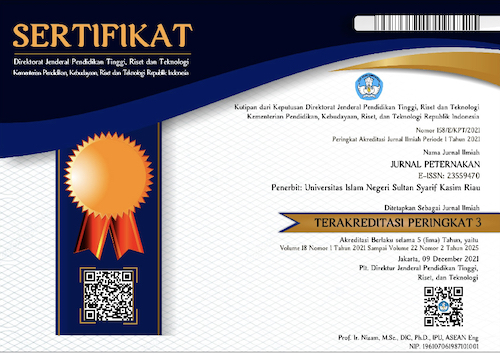Karakteristik Fermentabilitas dalam Rumen In vitro pada Pelepah Sawit Fermentasi yang Disuplementasi Tepung Kulit Jengkol
Abstract
Palm fronds are one of by-product plantation that ware potential used as animal feed. But the weaknesses were low digestibility and low nutrition. The processing of palm fronds with fermentation technology which combined with the addition of jengkol peel was one of method to improving the nutrition quality. The purpose of this study was to measure the digestibility and characteristics of rumen fluid in fermented palm oil fronds supplemented with jengkol peel powder. This study was designed in completely randomized with four treatments supplementation of jengkol peel powder at 0, 2, 4, and 6% and four groups as replications. Parameters analyzed were pH value, NH3 concentration, total VFA production, dry matter and organic matter digestibility. The data were analyzed using ANOVA and different among treatments means examined by Duncan Multiple Range Test. The result showed that the addition of jengkol peel powder at 2-6% to fermented palm fronds decreased (P<0.05) in-vitro dry matter and organic matter digestibility, rumen pH value, VFA Production and NH3 concentration. From this study it can be concluded that supplementation of jengkol peel powder on fermented oil palm fronds can reduce the digestibility of dry matter and organic matter in vitro, affecting the characteristics of rumen fluid (pH, VFA and NH3), but is still at optimal conditions for normal fermentation in rumen.
Keywords
Full Text:
PDF (Bahasa Indonesia)References
Astuti, T., M. N. Rofiq dan Nurhaita, 2017. Evaluasi Kandungan Bahan Kering, Bahan Organik Dan Protein Kasar Pelepah Sawit Fermentasi Dengan Penambahan Sumber Karbohidrat Jurnal Peternakan Vol 14 No 2 : 42–47
Azevêdo, J.A.G., V. Filho, D.S. Pina, E. Detmann, L.G.R. Pireira, R.F.D. Valadares, H.J. Fernandes,L.F.C., Silva., &P.B.Bened eti. 2012. Nutritional diversity of agricultural and agro-industrial by-products for ruminant feeding. Arq. Bras. Med. Vet. Zootec. 64:1246-1255
Fahey, G.C., & L.L. Berger. 1988. Carbohydrate nutrition of ruminants. In : D.C Chruch (Ed.). Digestive Phisiology and Nutrition of Ruminants. The Ruminant Animal. Prentice Hall Eglewood Cliifs, New Jersey
General Laboratory Procedures. 1966. Departement of Dairy Science. University of Wisconsin, Madinson
Hart K. J., D. R. Ya nez-Ruiz, S.M. Duval, N.R. McEwan, & C.J. Newbold. 2008. Plant extracts to manipulate rumen fermentation. J. Anim. Feed Sci. and Tech. 147:8– 35
Hidayah N. 2016. Pemanfaatan senyawa metabolit sekunder tanaman (tanin dan saponin) dalam mengurangi emisi metan ternak ruminansia. JSPI. 11:89-98
Hidayah, N., R. Lubis, K.G. Wiryawan, & S. Suharti. 2019. Phenotypic identification, nutrients content, bioactive compounds of two jengkol (Archidendron jiringa) varieties from Bengkulu, Indonesia and their potentials as ruminant feed. Biodiversitas. 20:1671-1680
Hu, W.L., J-X. Liu, J.A. Ye, Y.M. Wu & Y.Q. Guo. 2005. Effect of tea saponin on rumen fermentation in vitro. Anim. Feed Sci. Technol. 120:333–339
Hudaeby, A., I. Hernaman & U. H. Tanuwiria. 2012. Pengaruh Pemberian Ekstrak Kulit Manggis (Garcinia mangostana L.) pada Ampas Tahu terhadap Kadar NH3 dan VFA Cairan Rumen (In Vitro). Student e-journals.1: 1-7
Jayanegara, A. 2008. Reducing methane emissions from livestock: nutritional approaches. Proceedings of Indonesian Students Scientific Meeting (ISSM), Institute for Science and Technology Studies (ISTECS) European Chapter, 13-15 May 2008, Delft, the Netherlands: 18-21.
Jayanegara, A., A. Sofyan, H.P.S. Makkar & K. Becker. 2009. Kinetika produksi gas, kecernaan bahan organik dan produksi gas metana in vitro pada hay jerami yang disuplementasi hijauan mengandung tanin. Med. Pet. 32:120-129
Mc Donald, P., Edwards, R. A., Greenhalgh, J. F. D., 2002. Animal Nutrition. 6th Edition. Longman, London and New York. 543 p
Mueller-Harvey, I. 2006. Review unravelling the conundrum of tannins in animal nutrition and heath. J. of The Scie. of Food and Agric. 86:2010-2037.
Nurhaita., Ruswendi., Wismalinda, R., dan Robiyanto. 2014. Pemanfaatan Pelepah Sawit Sebagai Sumber Hijauan dalam Ransum Sapi Potong. Jurnal Pastura Vol 4 no 1: 38-41
Pen, B., C. Sar, B. Mwenya, K. Kuwaki, R. Morikawa & J. Takahashi. 2006. Effects of Yucca schidigera and Quillaja saponaria extracts on in vitro ruminal fermentation and methane emission. Anim. Feed Sci. Technol. 129:175–186
Sandi, Y. O., S. Rahayu, & S. Wardhana. 2013. Upaya peningkatan kualitas kulit singkong melalui fermentasi menggunakan Leuconostoc Mesenteroides pengaruhnya terhadap kecernaan bahan kering dan bahan organik secara in vitro. J. I. Peternakan.1 : 99 – 108.
Santoso, B. & B. Tj. Hariadi. 2007. Pengaruh suplementasi acacia mangium willd pada pennisetum purpureum terhadap karakteristik fermentasi dan produksi gas metana in vitro. Med. Pet. 30:106-113.
Stell, R. G. and J. H. Torrie. 1991. Prinsip dan Prosedur Statistik, Suatu Pendekatan Biometrik. Edisi 2. Alih Bahasa B. Sumantri. PT. Gramedia Pustaka Utama, Jakarta
Tavendale, M. H., L. P. Meagher, D. Pacheco, N. Walker, G. T. Attwood and S. Sivakumaran. 2005. Methane production from in vitro rumen incubation with Lotus pedunculatus and Medicago sativa, and effects of extractable condensed tannin fractions on methanogenesis. Anim. Feed Sci. Technol. 123-124:403-419
Tilley, J.M.A. & R.A. Terry. 1963. A two-stage technique for the in vitro digestion of forage crops. J. British Grasslan Soc. 18:104-111
Tillman, A. D., H. Hartadi, S. Prawirokusumo, S. Reksohadiprodjo & S. Lebdosoekojo. 1998. Ilmu Makanan Ternak Dasar. Cetakan Ke-5. Gadjah Mada University Press, Yogyakarta.
Wijayanti, E., F. Wahyono & Surono. 2012. Kecernaan nutrien dan fermentabilitas pakan komplit dengan level ampas tebu yang berbeda secara in vitro. Anim. Agric. J. 1: 167- 179
Wina, E., S. Muetzel, E. Hoffman, H.P.S. Makkar, & K. Becker. 2005. Saponins containing methanol extract of Sapindus rarak affect microbial fermentation, microbial activity and microbial community structure in vitro. Animal Feed Scie. and Tech. 121:159-174
Wiryawan, K.G., E. Wina & R. Ernawati. 1999. Pemanfaatan tanin kaliandra sebagai agen pelindung beberapa sumber protein bakan (in vitro). Prosiding Seminar Hasil-Hasil Penelitian Bidang llmu Hayati hal: 278-289
DOI: http://dx.doi.org/10.24014/jupet.v17i1.7710
Refbacks
- There are currently no refbacks.
Jurnal Peternakan has been accredited by Sinta 3 : Number 158/E/KPT/2021
Starting from Vol. 18 No. 1 Year 2021 to Vol. 22 No. 2 Year 2025
Jurnal Peternakan Indexed By:
Editorial Office:
Jurnal Peternakan
Faculty of Agriculture and Animal Science, State Islamic University of Sultan Syarif Kasim Riau.
H.R. Soebrantas street KM. 15,5 Panam – Pekanbaru city.
E-mail: jurnal.peternakan@uin-suska.ac.id
ejournal: http://ejournal.uin-suska.ac.id/index.php/peternakan

Creation is distributed under the Creative Commons Attribution 4.0 International License. View Mystats














